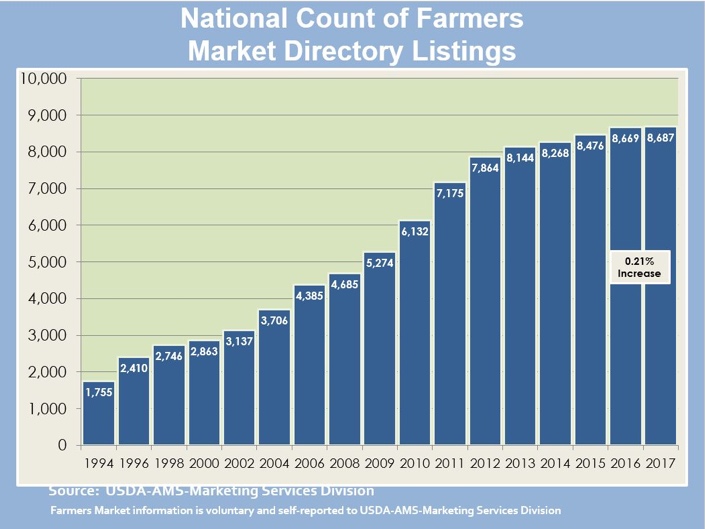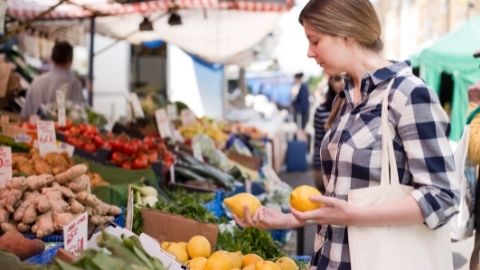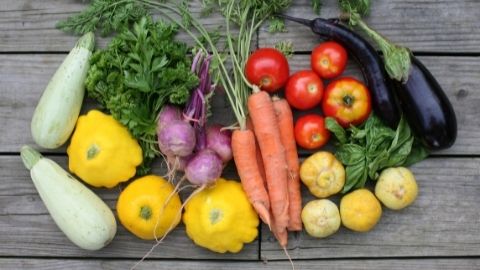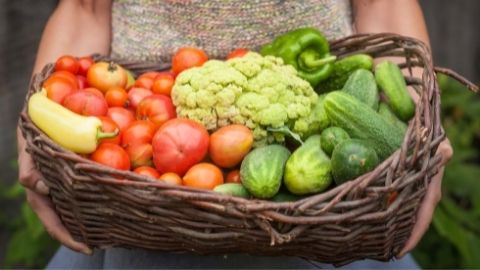Fresh Produce Direct Market Sales Considerations
Introduction
Direct market sales include the sale of farm products or services directly to the final consumer, local grocery or restaurant. Direct market sales can lead to increased returns for farmers as the costs of marketing and distribution are reduced through shortened transport distance. It may also decrease packaging costs and allow capturing additional profits that would otherwise go to a middleman in the distribution chain. Due to increased consumer demand for locally-produced and organic produce, many consumers are willing to pay a premium for fresh, high-quality, local produce, creating profit opportunity for growers who direct market profits. Also, direct markets allow growers to sell produce in smaller amounts or sell unique products that would otherwise be uncompetitive in wholesale markets.
Some direct market outlet alternatives include farmers markets, roadside farm stands, pick-your-own, farm stores and shops, community supported agriculture programs (CSAs), and selling directly to restaurants. When selecting a direct market(s), producers should evaluate their product offerings, market pricing, available resources, and target market to find a good fit. Several direct market options along with their advantages and challenges, for both producers and consumers, as well as target market characteristics are discussed below.

Farmers Markets
At a farmers market, fresh produce growers and food producers rent a booth at the market and sell produce and value-added products to consumers face-to-face. The popularity of local farmers markets has increased dramatically over the last two decades, but growth has leveled off in recent years. The number of farmers markets in the United States grew from 1755 in 1994 to over 8000 in 2017 (USDA AMS, 2017). Utah currently has 45 farmers markets statewide (USDA AMS, 2018).
Advantages and disadvantages of farmers markets for the producer:
Consumer demand for fresh, variety, and quality food is growing. Additionally, consumers now exhibit a greater concern for knowing where their food comes from and have a desire to reduce food miles and energy usage, which increases support for local agriculture. Face-to-face interaction - when customers are able to ask questions and hear the producer’s story - is important in creating a good relationship with the consumer and leads to increased and repeat sales. Another advantage is that farmers market managers often promote and advertise for their participating producers through the farmers market website and other promotional outlets.
A major difficulty of having a booth at a farmers market is that staffing the booth is required during the entire length of the market, including take down and set up. This can be inconvenient or costly if the grower themselves cannot be there. Another disadvantage is that sales and pricing can be uncertain and can fluctuate depending on market attendance, weather, etc.
Advantages of farmers markets for the consumer:
Farmers markets provide not only fresher, healthier produce, but a fun social and community event. Many farmers markets offer live music, demonstrations, and eating areas or picnic tables to encourage interaction. For many attendees, part of the fun of farmers markets is the social atmosphere and spending time with friends, family and community members. Primary farmers market consumer types and characteristics include (Curtis, 2011):
- Organic and Health Enthusiasts - These customers value healthy living (i.e., diet and exercise) and food safety. They are willing to pay a premium for organic and fresh foods and are not very concerned with pricing. They eat about 70% of meals at home and have high education levels. Producers can appeal to this group by clearly labeling their products for certified or non-certified organics and by providing information about their products including recipes, storage and nutritional/safety benefits. Suggesting wine pairings or meal plans is effective.
- “Homegrown” Enthusiasts - This group have larger families, are home gardeners and do high volumes of food preservation such as canning and storage. They eat 90% of their meals at open space. They are more concerned with price and are less willing to pay premium prices compared to the organic and health enthusiasts. To target homegrown enthusiasts, producers should label products with their origin and create family appeal at their booth by telling their ‘farm story’ through pictures and brochures. They can also provide suggestions about gardening, canning, preserving, cooking, pairing and preparing their produce.
General suggestions for selling at farmers markets include (Angeli-Salin, 2010):
- Present an attractive booth - Keep it clean and organized. Decor and signage should be colorful, creative, abundant and should match the mood or theme of the product (i.e., a booth of baked goods decorated with colorful, pastel ribbons).
- Use effective signage - Signs and labeling should be easy to read and simply stated. Show pricing. Be creative and tell a story. Display banners showing affiliation with a group or certification program like Utah’s Own.
- Employ well-trained staff - Staff members are the face of the business. They should know the rules of the farmers market and answer customer’s questions. Quality customer service is a must. Train staff to smile, acknowledge waiting customers, be friendly and set up sales for the next week. They should be able to describe the farm, growing practices, upcoming crops and product retail outlets.
- Create brand identity and tell your story - Who are you? Why are you special? Where are you from? These questions can help guide producers in creating an identity that is unique to them and their business. Use this brand identity consistently at each market at to increase name recognition. Use business name on signs, name tags, handouts, labels, etc.
- Build repeat customers - Successful vendors are the ones who build relationships with their customers and these loyal, repeat customers are crucial to success. Selling quality products at good prices, delivering consistent, friendly service and getting to know customers by name will go far in building a relationship of trust. Other ways to increase repeat sales is by giving away recipes, bags, tips, and handouts, collecting email addresses to advertise upcoming crops and specials, soliciting feedback and selling reusable containers (and offer a discount if they are returned). Simply saying “See you next week!” goes a long way.
Community Supported Agriculture (CSA) Programs
CSAs have been recognized as an effective way to connect producers with their local community. In a CSA, consumers purchase a subscription, or share, from a farmer or group of farmers. A share is a box of vegetables, fruits and other farm products like bread, jam, cheese, etc., and is delivered or picked up every week during the growing season. By purchasing a share, consumers are essentially buying equity into a farm. Consumer payments in advance of the season help farmers pay growing and other operational costs, and both the consumer and the farmer share the risk if there is a bad season.
Advantages and disadvantages of CSA programs for the producer:
Because the consumer makes advance payments, producers have cash flow to pay for seeds and other inputs before the harvest. The predefined market and know sales value also reduced the price risk that farmers face. CSA programs allows for better customer relationships, ease in obtaining feedback and understanding the make-up and needs of the target market. Many producers who run CSAs also sell at farmers markets or farm stands, furthering their credibility and branding.
Challenges associated with being in a CSA include the need for varied and high-quality produce. Share boxes require complex production, often 30 or more crops, making it more efficient to partner with other producers to share crops and provide greater variety for customers. Good communication, usually mediated by a CSA manager, is necessary between the shareholders and producers. Educating customers through newsletters that address seasonality, weather issues and recipes is effective but time-consuming, and while providing central drop-off locations where customers can pick up their produce is recommended, it requires further volunteers and additional coordination. Another challenge is the turnover of shareholders from year to year.
Advantages of CSA programs for the consumer:
Along with access to very fresh, healthy food, CSA participants get exposure to new types and varieties of vegetables and fruits. They are also introduced to farming and the growing process. As they develop a relationship with the farmer, support of local agriculture grows, leading to even more locally-produced, trusted and fresh produce.
Primary CSA consumer characteristics:
CSA members tend to be more highly educated and have higher rates of full-employment compared to farmers markets customers. They are usually female and are the primary shopper in their household. CSA customers prepare food at home more frequently than those at farmers markets. Food quality is important to them, while variety and appearance is less so. Supporting local farmers is important to them, but organic production methods are less important. There is a high incidence of vegetarians among CSA participants.
Suggestions for successful CSA programs include (Curtis, 2011):
- Provide recipes to CSA members
- Hold cooking demonstrations or other on-farm events
- Provide educational information on food preserving and gardening
- Allow half shares for single people or smaller families
- Include weekly newsletter addressing seasonality and current weather issues
- Provide home delivery service
Supplying Local Restaurants
Restaurant customers, especially when travelling, often request local and in-season products. Local produce can create value as it is perceived as fresher and higher quality, and often represents a local specialty proving and authentic or cultural experience (Curtis, Slocum, and Allen, 2015). Additionally, specialty varieties such as heirlooms are attractive to consumers for their uniqueness and presentation value. By sourcing locally, restaurants establish relationship with local growers, making it easier to adapt varieties and qualities of produce. Producers should target high-end and fine-dining establishments.
Advantages and disadvantages of supplying restaurants for producers:
The advantages of supplying restaurants include higher returns for produce sales. The customer base is more reliable and becoming a supplier provides the opportunity to build relationships with local businesses in the community. Some producers have found that they are able to grow and market special varieties or products that may not be lucrative in other markets.
There are several challenges, for example distributing produce takes time, requires some form of transportation and effective coordination with the restaurant. Fresh, local produce is seasonal and subject to weather and annual conditions and while restaurant sales are frequent, they tend to be low volume. Because chefs move often and restaurants close, there is a high turnover rate between the supplier and their point of contact. Another challenge is that meeting packaging, labeling and processing regulations can be complicated and costly.
How to approach restaurants and chefs:
Contacting a chef and establishing a good relationship with them is critical. Before meeting with them, do research on the restaurant's menu, clientele and food philosophy. Understanding this will aid in offering products are well suited to the establishment’s needs. Get to know the key personnel- chefs, owners, managers, etc. and find out how they wish to be contacted and when. Be sure to never contact them during key meal service times.
Other suggestions when selling to restaurants include:
- Invite chef or buyer to the farm.
- Bring samples of produce to share with the chef or buyer.
- Schedule a winter visit for crop planning.
- Prepare a “story” about the farm.
- Provide overview of products, volume, packaging and availability.
- Regularly update chefs on availability.
- Grow unique items and select the best products for chefs.
- Make weekly contact at an agreed time.
- Provide deliveries on time.
- Immediately notify chefs of potential shortages or changes in delivery.
Advantages of sourcing locally for restaurants:
- Local suppliers can be more reactive and innovative in times of high demand or during unexpected circumstances (i.e., bad weather, drought, etc.).
- Shorter supply chains mean greater certainty and predictability of delivery times and lower delivery costs.
- Less likelihood of disruptive and costly contamination recalls.
- Opportunity to serve customers with local food preferences.
- Greater ability to cater menus to seasonal availability.
- Business recognition for positive community support.
Conclusions
Direct to consumer markets often include farmers markets, roadside farm stands, pick-your-own, farm stores and shops, community supported agriculture programs (CSAs), and selling directly to restaurants. When selecting a direct market(s), producers should evaluate their product offerings, market pricing, available resources, and target market to find a good fit. Each direct market option has its own advantages and challenges, for both producers and consumers, and caters to distinct target markets.
Sales through direct markets are a popular alternative to traditional wholesale distribution for fresh produce growers as they allow the product to capture additional profits that would otherwise go to a middleman. Additionally, as consumer demand increases for locally-produced and organic produce, many consumers are willing to pay a premium for fresh, high-quality, local produce, creating a profit opportunity for growers who direct market through higher pricing. Also, direct markets allow growers to sell produce in smaller amounts or sell unique products that would otherwise be uncompetitive in wholesale markets.
References
- Angeli-Salin, K. (2010). “Selling Your Produce at a Farmers market.” Presentation at the Utah Building Farmers Workshop, November 2010, Kaysville, UT.
- Curtis, K., S. Slocum, and K. Allen. (2015). “Farm and Food Tourism: Exploring Opportunities.” Utah State University Extension Curriculum. Online at: http://diverseag.org/htm/farm-and-food-tourism.
- Curtis, K.R. (2011). “Direct Marketing Local Foods: Differences in CSA and Farmers market Consumers.” Utah State University Extension Fact Sheet, Applied Economics/2011-01pr (English), 2011-01pr, sp (Spanish).
- United States Department of Agriculture, Agricultural Marketing Service (USDA-AMS)(2018). Local Food Directories: National Farmers Market Directory. Online at: https://www.ams.usda.gov/local-food-directories/farmersmarkets.
- United States Department of Agriculture, Agricultural Marketing Service (USDA-AMS)(2017). National County of Farmers Market Directory Listings. Online at: https://www.ams.usda.gov/sites/default/files/media/NationalCountofFMDirectory17.JPG.
This material is based upon work supported by USDA/NIFA under Award Number 2015-49200-24225.
Date Published: December 2018
Authors
Kynda R. Curtis, Professor and Extension Specialist, Department of Applied Economics; Sierra Allen, Undergraduate Research Assistant, Department of Applied Economics; Susan Slocum, Associate Professor, Tourism and Event Management, George Mason University
Related Research








